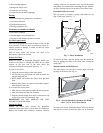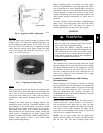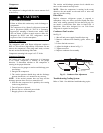
580J*04--12
NOMINAL 3 TO 10 TONS
WITH PURONr (R410A) REFRIGERANT
Service and Maintenance Instructions
TABLE OF CONTENTS
SAFETY CONSIDERATIONS 1....................
UNIT ARRANGEMENT AND ACCESS 2...........
SUPPLY FAN ( BLOWER) SECTION 4..............
COOLING 5....................................
PURONR (R410A) REFRIGERANT 8...............
COOLING CHARGING CHARTS 9.................
CONVENIENCE OUTLETS 15....................
SMOKE DETECTORS 16.........................
SENSOR AND CONTROLLER TESTS 19...........
PROTECTIVE DEVICES 22.......................
GAS HEATING SYSTEM 23......................
ECONOMIZER SYSTEMS 33.....................
PRE START--UP 42..............................
START--UP, GENERAL 42........................
OPERATING S EQUENCES 43.....................
FASTENER TORQUE VALUES 45.................
WIRING DIAGRAMS 46.........................
APPENDIX I. MODEL NUMBER SIGNIFICANCE 48.
APPENDIX II. PHYSICAL DATA 49................
APPENDIX III. FAN PERFORMANCE 55...........
APPENDIX IV. ELECTRICAL DATA 65.............
APPENDIX V. WIRING DIAGRAM LIST 70.........
APPENDIX V I. MOTORMASTER SENSOR
LOCATIONS 71.................................
UNIT START-UP CHECKLIST 73..................
SAFETY CONSIDERATIONS
Installation and servic ing of air-conditioning e quipment
can be hazardous due to system pressure and electrical
compone nts. Only trained and qualified service personnel
should install, repair, or service air-conditioning
equipment. Untrained personnel can perform the basic
maintenance functions of replacing filters. Trained service
personnel should perform all other operations.
When working on air-conditioning equipme nt, observe
precautions in the literature, tags and labels attached to
the unit, and other safety precautions that may apply.
Follow all safety codes. Wear safety glasses and work
gloves. Use quenching cloth for unbrazing operations.
Have fire extinguishers available for all brazing
operations.
Follow all safety codes. Wear safety glasses and work
gloves. Use quenching cloth for brazing operations. Have
fire extinguisher available . Read these instructions
thoroughly and follow all warnings or caut ions attached to
the unit. Consult local building codes and National
Electrical Code (NEC) for special requirements.
Recognize safety information. This is the safet y--alert
symbol
. When you see t his symbol on the unit and in
instructions or manuals, be alert to the potential for
personal injury.
Understand the signal words DANGER, WARNING, and
CAUTION. These words are used with the safety-- alert
symbol. DANGER identifies the most serious hazards
which will result in severe personal injury or death.
WARNING signifies a hazard which could result in
personal injury or death. CAUTION is used to identify
unsafe practices which may result in minor personal
injury or product and property damage. NOTE is used to
highlight suggestions which will result in enhanced
installation, reliability, or operation.
FIRE, EXPLOSION HAZARD
Failure to follow this warning could result in
personal injury, death and/or property damage.
Refer t o the User’s Information Manual provided
with this unit for more details.
Do not store or use gasoli ne or other fl ammable
vapors and liquids in the vicinity of this or any other
appliance.
What to do if you smell gas:
DO NOT try to light any appliance.
DO NOT touch any electric al switch, or use any
phone in your building.
IMMEDIATELY call your gas suppli er from a
neighbor’s phone. Follow the gas supplier’s
instructions.
If you cannot reach your gas supplier, call the fire
depart ment.
!
WARNING


















